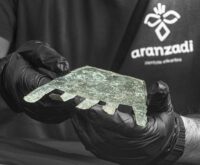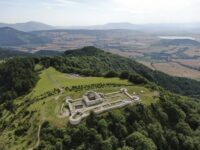 A bronze hand from the 1st century B.C. discovered on Mount Irulegi near Pamplona in northern Spain is the first document written in the Basque language. The Hand of Irulegi is a flat bronze plate cut from a single sheet of bronze into the shape of a life-sized right hand with five fingers. It is 5.7 inches long and engraved with 40 symbols on four lines across the back of the hand. Metal composition analysis found that the bronze is an alloy of 53.19% tin, 40.87% copper and 2.16% lead, a proportion typical of ancient bronze.
A bronze hand from the 1st century B.C. discovered on Mount Irulegi near Pamplona in northern Spain is the first document written in the Basque language. The Hand of Irulegi is a flat bronze plate cut from a single sheet of bronze into the shape of a life-sized right hand with five fingers. It is 5.7 inches long and engraved with 40 symbols on four lines across the back of the hand. Metal composition analysis found that the bronze is an alloy of 53.19% tin, 40.87% copper and 2.16% lead, a proportion typical of ancient bronze.
It was unearthed in June 2021 in the vestibule of a mud-brick house from an Iberian settlement at the foot of a hill topped by a medieval castle. Ceramic fragments, coins and the bones of domestic animals were also discovered inside the dwelling. The finds date to the first quarter of the 1st century B.C.  This was a troubled time in the Roman province of Hispania. The Sertorian War pitted rebel Roman general Quintus Sertorius and his Iberian allies against the forces of the Roman Senate, led by generals Quintus Caecilius Metellus Pius and Gnaeus Pompeius Magnus. Mount Irulegi was caught in the crossfire. Pompey’s troops burned the settlement to the ground. The hand and other artifacts were found under this burn layer.
This was a troubled time in the Roman province of Hispania. The Sertorian War pitted rebel Roman general Quintus Sertorius and his Iberian allies against the forces of the Roman Senate, led by generals Quintus Caecilius Metellus Pius and Gnaeus Pompeius Magnus. Mount Irulegi was caught in the crossfire. Pompey’s troops burned the settlement to the ground. The hand and other artifacts were found under this burn layer.
The inscription was not visible on the surface when the hand was first recovered. Archaeologists thought it might be a helmet fitting at first, but the inscriptions emerged after cleaning. This spring, epigraphers and experts in Indo-European languages examined the inscription. The found the writing is the Paleohispanic family, but not the Iberian or Celtiberian semi-syllabaries. Instead it is an example of a subsystem that is unique to itself, albeit with elements adapted from Iberian scripts.
For example, the inscription includes the symbol T, which has already been identified on two coins, supporting the theory of the existence of a particular subsystem, as such a sign does not exist among the rest of the Hispanic script systems. In addition, the system of letters and semi-syllabary of the Hand of Irulegi includes two vibrating signs, which makes it possible that it is an adaptation of the Iberian script, as the Celtiberian script lacked one of them. How, when and where the Vascones adapted the Iberian script is unknown, but it does completely rule out the theory that they were a people who lacked a writing system, as had previously been thought, but that “they knew the writing and had made use of it, if not extensively then at least not negligibly.”
The phrases on the Hand of Irulegi are separated by dots or marks (interpunctuations), but none of the identified words appear to correspond to personal Basque names, and since the names of Paleohispanic gods are largely unknown to experts, they believe that some of the words may refer to Basque divinities or places.
What epigraphers have distinguished is the first word of the text: sorioneku, which is very similar to the Basque word zorioneko, formed by the sequence zori (fortune) and on (good), which can be translated as “of good fortune or good omen.” The rest of the inscription raises more questions, the researchers admit. They do though believe they have detected some recognizable words such as es (ez in modern Basque), an adverb of negation, and perhaps also a form relatable to the verb egin (to do).
“What is beyond doubt,” conclude [linguists] Velaza and Gorrochategui, “is that the exceptional Irulegi inscription proves that the Basques were using their language in that territory in the 1st century BC. And, taking into account the scarcity of firm testimonies for the establishment of the linguistic map of the area and of the protohistory of the Basque language, its discovery creates an inescapable basis for any debate on the question. The Hand of Irulegi constitutes the first document undoubtedly written in the Basque language.”
Before this discovery, the Vascones, the late Iron Age Iberian tribe whose language was the ancestor of modern-day Basque, were believed to have no written language beyond a few words used only on coins until the introduction of the Latin alphabet by Romans. The Hand of Irulegi inscription upends that hypothesis.